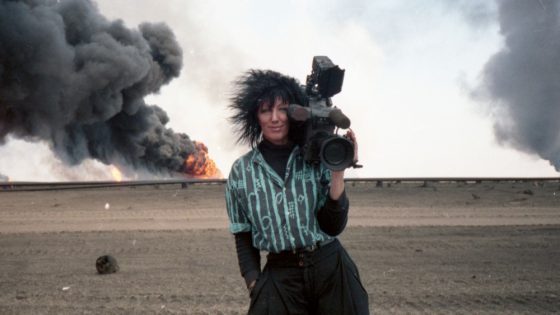The thin line between cheating death and chasing it appears to have been smudged, repeatedly, by maverick video journalist Margaret Moth, the subject of first-time filmmaker Lucy Lawless’ fascinating documentary “Never Look Away.” At least, that’s the impression we’re left with at the end of this compact yet complex portrait of a singularly and aggressively unconventional war correspondent who inspired equal measures of admiration and anxiety among her friends, colleagues and lovers throughout her 20 years of assignments in the world’s trouble spots — Baghdad, Sarajevo, Afghanistan, Lebanon, Zaire, you name it, she was there — for CNN.
Something of an enigma even to those closest to her — “I never fully understood what was ticking inside of her” is a comment typical of responses by interviewees questioned by an off-camera Lawless — Moth was fond of proudly proclaiming, “I live life to the fullest.” But it was a life she repeatedly risked by going places, doing things and recording wartime horrors with such little regard for her own safety that a CNN teammate warned her: “There’s only so much Russian Roulette you can play.”
It was also a life that she more or less reinvented herself to portray. Born Margaret Wilson to a working-class family in Gisborne, New Zealand, she changed her name to Moth, dyed her blonde hair jet-black, and routinely applied enough Goth eyeliner to cosplay a young Joan Jett before moving to Houston, Texas in the early 1980s to work as a news cameraperson at CBS affiliate KHOU. (The movie hints, ever so subtly, that covering hurricanes in and around the Gulf Coast area may have been great training for being a war correspondent.)
She was an unabashed hedonist, freely indulging in booze, controlled substances and casual sex — at age 30, she took then 17-year-old Jeff Russi as a lover, who recalls that he was immediately smitten by the spiky-haired nonconformist he romantically viewed as “looking like a gypsy fortune teller,” and admits theirs was an open relationship in which she set down the rules. For all that, however, Moth sufficiently impressed the right people to land a job with CNN in 1990.
Over the next two decades, Moth attained near-legendary status among her colleagues and superiors with her willingness — no, make that eagerness — to get as close to the “messy, human reality of war.” At one point, while other photojournalists dived for cover behind cars as militiamen opened fire on protesters in Tbilisi, Georgia, she stood her ground and turned her camera on the violence.
One night in Tyre, Lebanon, during yet another clash between Hezbollah and Israel, she boldly remained on the rooftop of an apartment block where she and other journalists had established headquarters, camera at the ready, just in case Israel would retaliate for a missile attack launched from a nearby site. Most of her less reckless colleagues sought shelter in the basement. Moth held her ground on the roof, waiting for a counterattack that, fortunately, never came.
Unfortunately, there really is a limit to how much Russian Roulette you can play. While motoring through the infamous Sniper Valley of Sarajevo in 1992, Moth was shot in the head and severely injured — she lost part of her tongue and most of the lower part of her face. Not surprisingly, that did not stop her. Six months later, she returned to work in Sarajevo after multiple surgeries with her speech slurred, her face scarred, and her addiction to adrenaline undiminished.
Lawless — heretofore best known as star of TV’s “Xena: Warrior Princess” — strikes a delicate balance between hagiography and brutal honesty while constructing her narrative from archival footage and talking-heads interviews. Chief among those offering testimonials: Russi, who remained Moth’s friend long after she departed Houston; Yaschinka, a French sound recordist who also became her lover and confidant; and CNN correspondent Christiane Amanpour, who vividly recounts how she actually apologized to Moth for bringing her into a particularly hazardous situation, then went out with her the following day to resume their coverage.
Much of the movie’s first half is devoted to establishing Moth as a courageous libertine with a possible death wish and an unquenchable desire to always “get the shot” while repeatedly focusing on the innocents of all ages caught in the crossfire. Time and again during “Never Look Away,” you may find yourself flinching at images of the wounded and the dead.
It’s not until around the midway point that Lawless backs up to show us an equally disturbing image, drawn by Moth during her emotionally scarring childhood in a home where she and her siblings lived in constant fear of their abusive father. (“We never knew,” says one of her sisters, “when dad was going to come home sober, or come home at all.”) It’s a nightmarish illustration of children terrified by a monstrous figure, suggesting that, early on, little Margaret deduced there were things in life more terrifying than war zones.
Lawless had no footage of Moth during her most death-defying episodes, but the filmmaker satisfyingly solves that problem by using meticulously detailed models and physical-scale dioramas to illustrate those incidents.
Although we periodically hear recordings of Moth before and after her shooting, Lawless was not able to interview Moth herself — the photojournalist died of cancer in 2010. In the end, however, you can’t help thinking such a conversation would not have revealed more than other interviews Lawless was able to conduct. “Never Look Away” gives us as complete a portrait as seems humanly possible, for which Lawless merits abundant credit. Trouble is, some people quite simply are unknowable — even by those who may think they know them best. Sometimes, especially by them.
Source Agencies

